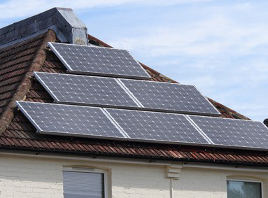Small & Medium Renewable Energy Market Report – UK 2016-2020
Available as an Instant Download PDF
Over the last 10 years there have been significant changes in legislation in relation to improving the energy-efficiency of homes in the UK. Barbour ABI first published a review of sustainable and energy-efficient products in domestic applications in 2003. Previous reports have focused on Microgeneration, that is on renewable electricity generating plants up to 50 kWe capacity and on renewable heat schemes up to 45 kWth. This report expands to include small and medium sized electricity generation schemes up to 5 MW and heat generation schemes up to 200 kWth. The justification for choosing these parameters is that they are in line with the upper limits for eligibility to the Feed In Tariff (FIT) and Renewable Heat Incentive (RHI) programmes. Detailed market data and insight on the small & medium renewable energy market by Barbour ABI, a leading UK provider of construction market intelligence.
£700.00 Exc. VAT
The report ‘Small & Medium Renewable Energy Market Report – UK 2016-2020’ builds on Barbour ABI’s previous reports on the microgeneration market, and the scope of the report has been expanded to cover renewable electricity generation up to 5MW and renewable heat generation up to 200 kWth. Drawing together information and data from a wide range of sources, and with over 50 charts and tables, this report provides an integrated overview of recent trends and market prospects for renewable electricity and heat generation technologies including; solar PV and thermal, windpower, hydropower, anaerobic digestion & biomass boilers and heat pumps.
Key sections covered:
- Review of small and medium renewable energy technologies – solar photovoltaics, windpower, hydropower, anaerobic digestion with biogas, solar thermal and biomass boilers & wood fuelled stoves, ground & air source heat pumps.
- Overview of the renewable energy sector – key market factors – Feed In Tariff (FIT), Renewable Heat Incentive (RHI), Renewables Obligation etc.
- Recent developments – impact of FIT, RHI and RO on annual number of installations & capacity installed for each, changes made by the new Conservative government affecting climate change and renewable energy policy.
- Future prospects – market forecasts by installed values for 2018 and 2020.
Key areas of insight include:
- Market overview by capacity, installation numbers and estimated installed values.
- Technology sector sizes by installed capacities & numbers of installations, end user mixes and by tariff capacity bands.
- Assessment of impacts of Feed -In Tariff, Renewable Heat Incentive etc. 2010 -2015 and on forecasts by value for 2018 and 2020.
- Detailed market data and insight on the small & medium renewable energy market by Barbour ABI, a leading UK provider of construction market intelligence.
Market Overview
- Overview of trends in total fossil fuel and renewable energy generation 2010 -2014 by technology type.
- Overview of market size and trends for small -medium renewable energy 2010 -2015 by capacity and by value.
- Identification of key market drivers for the 2010 -2015 period – Feed in Tariff, Renewable Heat Incentive, Renewables Obligation.
- Market forecasts by installed values for 2018 and 2020.
Solar PV to 5MW
- Total solar PV market by capacity; split by FIT, RO, unaccredited & cumulative trends 2010-2015.
- Sub 5 MW solar PV market 2010 -2015 by annual capacity installed; split by FIT, RO etc; identification of key drivers e.g. FIT, RO and falling costs.
- Market mixes and trends 2010-2015 by capacity bands; sub 50 kW and >50kW -5 MW.
- End user mix by capacity installed & trends; domestic, commercial & industrial.
- Market forecasts by installed values for 2018 and 2020, and key factors impacting e.g. reduced subsidies.
Onshore Windpower to 5MW
- Overall sub 5 MW windpower market 2010 -2015 by annual capacity installed; identification of key drivers e.g. FIT etc.
- Market mixes and trends 2010-2015 for each of the FIT capacity bands from <= 15kW up to >1,500 kW.
- Overview of total end use mix by capacity installed; domestic, commercial & industrial; End use mixes within each of the FIT capacity bands and trends.
- Market forecasts by installed values for 2018 and 2020, and key factors e.g. reduced subsidies.
Hydropower to 5MW
- Overall market by capacity; split by FIT, RO. Trends for total and FIT capacity to 2015.
- End user mixes by number installations & by capacity size bands and market trends.
- Market forecasts by installed values for 2018 and 2020, and key factors.
Solar Thermal
- Recent trends by area installed 2010 – 2015 and key factors e.g. RHI.
- End use market mix, domestic vs commercial.
- Market forecasts by installed values for 2018 and 2020, and key factors.
Biomass – Wood Fuelled Boilers & Stoves and Anaerobic Digestion
- Anaerobic digestion with biogas – market trends by plant numbers & capacity 2010 -2015. Key trends in on-farm and commercial; Trends in number of plants by sector; water, on-farms & commercial; Trends in FIT sector by capacity bands 2009 -2014. Market forecasts by installed values for 2018 and 2020, and key factors.
- Biomass boilers – non domestic installations under RHI: trends by capacity 2012-2015, mix by size, market mix by end user by capacity. Market size & trends in domestic installations for 2018 and 2020.
Ground Source Heat Pumps
- Overview of market size & trends by numbers supplied, 2010-2015; market factors.
- Installations under the non-domestic RHI; market mix air vs ground source.
- Installations under the domestic RHI; market mix air vs ground source and by applications.
- Market forecasts by installed values for 2018 and 2020, and key factors.
This edition of this biennial report has been extended from covering just the renewables microgeneration sector and renewable heat generation, to covering small and medium size renewable electricity and heat generation. The upper limits are in accordance with the parameters of the Feed In Tariff (FIT) and Renewable Heat Incentive (RHI) subsidy programmes, which are for installed capacities of 5 MW and 200 kWth respectively. While the FIT incentive has been almost the sole demand driver for nearly all sub 5 MW solar PV schemes, other small-medium size renewable energy projects have been developed either under the Renewables Obligation (RO) or without government support. While the RO was closed off to new sub 5 MW developments after the launch of FIT, it still continued to support new developments in Northern Ireland, where the FIT is not available.
Market values in the small and medium renewable electricity and renewable heat market, at estimated installed values, saw a peak in 2011, reflecting the highly advantageous subsidies at that time. Since then, the market has fluctuated but remained at a level above £2bn per annum. The main driver has been solar photovoltaics (PV), which accounts for over 80% of all renewable electricity and 98% of all installations under the FIT. While private households have been the main area of application, since 2012 this market has declined while demand from the commercial sector has grown. All other small-medium size renewable energy technologies have shown growth since the introduction of FIT in 2010, albeit at much more modest rates than the solar PV market. The RHI subsidy programme has also provided a significant boost to the number of renewable heat technologies, although wood-fuelled boilers are by far the most widely installed type in the non-domestic sector. In the domestic sector, the main area of demand has been for heat pumps and, to a lesser extent, wood-fuelled boilers.
The forecasts through to 2020 illustrate the expectation that the market is likely to face significant challenges, in the form of reducing Government support as well as lower levels of gas and electricity prices. This is likely to mean that any growth in the market will be at an individual product level, rather than an overall market level, unless the Government provides a greater level of support. While the prospects for solar PV and windpower do not look promising, other sector are expected to fare better, in particular non-water industry anaerobic digestion (AD). One of the least mature renewable technologies, the impact of digression has been relatively small because new capacity coming on-stream each quarter has not been sufficiently high to trigger large drops in tariff rates. One key factor expected to drive the market is the recent availability of RHI tariffs for biomethane-to-grid injection. With negligible capacity prior to 2014, it increased by over 400% in 2014 and is forecast to grow fourfold in 2016.
Unlike solar PV and windpower FIT tariffs, the RHI programme appears to be relatively safe for now, with £1.5bn a year of support pledged by the Government in the Autumn 2015 review. How this is apportioned across the eligible technologies is as yet unknown but as well as AD biomethane, heat pumps and commercial wood-fuelled boilers are likely to benefit from increased demand. In spite of this, the whole renewables industry is now faced with a raft of problems that could curtail growth, including the proposed implementation of EU requirements to raise VAT levels to 20%, the removal of the Climate Change Levy Exemption Certificates (LECs) for all renewable power generation, whether new or existing schemes, the withdrawal of the Allowable Solutions scheme and the abandonment of the Zero Carbon Homes targets, and the removal of tax breaks for community energy projects.
- Contents Listing
- 1. INTRODUCTION 8
- 1.1 BACKGROUND 8
- 1.2 SOURCES OF INFORMATION 8
- 2. SUMMARY 10
- 3. ECONOMIC ENVIRONMENT 12
- 3.1 GDP 12
- 3.2 INFLATION & INTEREST RATES 13
- 3.3 UNEMPLOYMENT 14
- 3.4 HOUSEHOLD CONSUMPTION 14
- 3.5 HOUSING & CONSTRUCTION 15
- 3.6 STERLING 16
- 3.7 POPULATION PROFILE 16
- 3.8 CONCLUSIONS 17
- 4. MARKET SIZE AND TRENDS 18
- 4.1 DEFINITION 18
- 4.2 RENEWABLE ENERGY OVERVIEW 19
- 4.3 SUB 5 MW RENEWABLE ENERGY MARKET SIZE AND TRENDS 21
- 4.4 MARKET PROSPECTS 24
- 4.4.1 Overview 24
- 4.4.2 Reduction in Feed In Tariffs 26
- 4.4.3 Proposed Exemption to 5% VAT Rate 27
- 4.4.4 Removal of Climate Change Levy Exemption Certificates 27
- 4.4.5 Abandonment of the Zero Carbon Homes Policy 27
- 4.4.6 Community Energy And Withdrawal Of Tax Breaks 28
- 4.4.7 Closure of the RO to New Sub 5 MW Solar PV and Onshore Windpower 28
- 5. SOLAR PV 30
- 5.1 INTRODUCTION 30
- 5.2 RECENT TRENDS 30
- 5.2.1 Overview of Total Solar PV Market 30
- 5.2.2 Solar PV up to 5 MW 32
- 5.2.3 End User Mix 37
- 5.3 MARKET PROSPECTS 38
- 5.4 SUPPLY 40
- 6. ONSHORE SMALL TO MEDIUM WINDPOWER 41
- 6.1 DEFINITION 41
- 6.2 RECENT TRENDS 41
- 6.3 MARKET PROSPECTS 46
- 6.4 SUPPLY 47
- 7. SMALL SCALE HYDROPOWER 48
- 7.1 INTRODUCTION 48
- 7.2 MARKET TRENDS 48
- 7.3 MARKET PROSPECTS 51
- 7.4 SUPPLY 52
- 7.4.1 Developers and Operators 52
- 8. SOLAR THERMAL 53
- 8.1 INTRODUCTION 53
- 8.2 RECENT TRENDS 54
- 8.3 END USE MARKETS FOR SOLAR THERMAL SYSTEMS 55
- 8.4 MARKET PROSPECTS 55
- 9. BIOMASS 57
- 9.1 INTRODUCTION 57
- 9.2 ANAEROBIC DIGESTION 57
- 9.2.1 Recent Trends 57
- 9.2.2 Market Prospects 60
- 9.3 BIOMASS BOILERS 61
- 9.3.1 Market Size and Trends 61
- 9.3.2 Suppliers 63
- 10. HEAT PUMPS 65
- 10.1 INTRODUCTION 65
- 10.2 RECENT DEVELOPMENTS 66
- 10.3 MARKET PROSPECTS 68
- 10.4 SUPPLY 68
- Tables & Charts
- CHART 1 UK MARKET FOR SMALL -MEDIUM RENEWABLE ENERGY SCHEMES BY INSTALLED VALUES (£M) 2010 -2015 AND FORECASTS 2018 AND 2020 10
- TABLE 2 GDP DATA – 2012-2015 – KEY CONSTITUENT ELEMENTS 12
- CHART 3 INTEREST RATES AND INFLATION (CPI) FROM 2000-2020 14
- CHART 4 PDI & SAVINGS RATIO AT CURRENT PRICES 2000-2020 15
- TABLE 5 EXCHANGE RATE FLUCTUATIONS 2011-2017 – STERLING TO THE DOLLAR, AND THE EURO, SPOT RATES 16
- CHART 6 UK ELECTRICITY GENERATION SHARE BY FUEL TYPE (COAL, GAS, NUCLEAR, RENEWABLES AND OTHERS*) GWH 2009-2014 19
- CHART 7 SMALL-MEDIUM (UP TO 5 MW) RENEWABLE ENERGY MARKET BY % SHARE BY TECHNOLOGY BY ESTIMATED INSTALLED VALUES 2015 21
- CHART 8 UK MARKET FOR SMALL -MEDIUM RENEWABLE ENERGY SCHEMES BY INSTALLED VALUES (£M) 2010 -2015. 22
- CHART 9 TOTAL QUARTERLY INSTALLED SUB 5 MW CAPACITY (MW) UNDER FIT APRIL-JUNE 2010 TO SEP 2015. 23
- CHART 10 TOTAL INSTALLED RENEWABLE ELECTRICITY CAPACITY UNDER FIT (MW) BY TECHNOLOGY 1 APRIL 2010 – 31 SEPTEMBER 2015 23
- CHART 11 RENEWABLE HEAT INCENTIVE – TRENDS IN THE NUMBER OF QUARTERLY ACCREDITED INSTALLATIONS 2012 -2015 24
- CHART 12 FORECASTS FOR SMALL-MEDIUM RENEWABLE ENERGY SCHEMES BY INSTALLED VALUES (£M) 2015, 2018 AND 2020 25
- TABLE 13 NEW GENERATION FEED IN TARIFFS FEBRUARY 2016 26
- CHART 14 TOTAL SOLAR PV INSTALLATIONS BY SUBSIDY SCHEME (FIT, RO, ETC) BY INSTALLED CAPACITY (MW) AS OF DECEMBER 2015 31
- CHART 15 UK SOLAR PV BY CUMULATIVE INSTALLED CAPACITY BY SUBSIDY SCHEME (FIT, RO, OTHER, TOTAL) 2009-2015 32
- CHART 16 ANNUAL TRENDS IN SUB 5 MW SOLAR PV SECTOR (FIT & RO COMBINED) BY CAPACITY (MW) 2009 – 2015 33
- CHART 17 TOTAL SUB 5 MW SOLAR PV INSTALLATIONS BY SUBSIDY SCHEME (FIT, RO, ETC BY INSTALLED CAPACITY (MW) 2015 34
- CHART 18 AVERAGE INSTALLATION COSTS PER KW FOR 4 KW ROOF MOUNTED SOLAR PV SYSTEMS APRIL 2010 -FEBRUARY 2015 35
- CHART 19 SOLAR PV INSTALLED CAPACITY BY SIZE BAND SINCE THE FIRST ROUND OF DEGRESSION IN 2012 35
- CHART 20 SUB 50 KW SOLAR PV SYSTEMS – QUARTERLY INSTALLED CAPACITY (MW) BY SUBSIDY SCHEME (FIT, RO) JANUARY -MARCH 2010 TO APRIL -JULY 2015. 36
- CHART 21 50 KW – <5 MW SOLAR PV SYSTEMS – QUARTERLY INSTALLED CAPACITY (MW) BY SUBSIDY SCHEME (FIT, RO) JANUARY -MARCH 2010 TO APRIL -JULY 2015. 37
- CHART 22 SUB 5 MW SOLAR PV SUPPORTED BY FIT AND RO (MW) BY END USE SECTOR BY CAPACITY 1 APRIL 2010 – Q3 2015 38
- CHART 23 FORECASTS FOR SUB 5 MW SOLAR PV BY INSTALLED VALUES (£M) 2015, 2018 AND 2020 39
- TABLE 24 FEED IN TARIFFS FOR SOLAR PV INSTALLATIONS FEBRUARY 2016 VS OCTOBER -DECEMBER 2015 39
- TABLE 25 FIT BANDING FOR WINDPOWER SCHEMES BY INSTALLED CAPACITY 41
- CHART 26 SMALL -MEDIUM ONSHORE WINDPOWER SUPPORTED BY FIT BY INSTALLED CAPACITY (MW) 2009 – 2015 42
- CHART 27 SMALL-MEDIUM WINDPOWER SUPPORTED BY FIT BY END USE SECTOR BY INSTALLED CAPACITY (MW) 1 APRIL 2010 – 31 SEPTEMBER 2015 42
- CHART 28 SMALL-MEDIUM WINDPOWER SUPPORTED BY FIT BY CAPACITY BANDS (MW) 2009 -2015 43
- CHART 29 SMALL-MEDIUM WINDPOWER BY END USERS BY FIT INSTALLED CAPACITY UP TO 15 KW 1 APRIL 2010 -31 SEPTEMBER 2015 44
- CHART 30 SMALL-MEDIUM WINDPOWER BY END USERS BY FIT INSTALLED CAPACITY >15-100 KW 1 APRIL 2010 -31 SEPTEMBER 2015 44
- CHART 31 SMALL-MEDIUM WINDPOWER BY END USERS BY FIT INSTALLED CAPACITY UP TO >100 – 500 KW 1 APRIL 2010 -31 SEPTEMBER 2015 45
- CHART 32 SMALL-MEDIUM WINDPOWER BY END USERS BY FIT INSTALLED CAPACITY OVER 500 KW 1 APRIL 2010 -31 SEPTEMBER 2015 45
- CHART 33 FORECASTS FOR SMALL -MEDIUM WINDPOWER (UP TO 5 MW) BY INSTALLED VALUES (£M) 2015, 2018 AND 2020 46
- TABLE 34 WINDPOWER TARIFF RATES FEBRUARY 2016 VS APRIL -SEPTEMBER 2015 46
- CHART 35 SMALL – MEDIUM HYDROPOWER BY % OF INSTALLATIONS BY CAPACITY SIZE BANDS (KW) 48
- CHART 36 SMALL- MEDIUM SCALE HYDROPOWER – TOTAL INSTALLED CAPACITY (MW) BY SUBSIDY PROGRAMME IN 2015 49
- CHART 37 SMALL-MEDIUM SCALE HYDROPOWER BY TOTAL NUMBER OF INSTALLATIONS SUPPORTED BY FIT BY END USERS 49
- CHART 38 SMALL-MEDIUM SCALE HYDROPOWER BY TOTAL CAPACITY (MW) SUPPORTED BY FIT BY END USERS 2015 50
- CHART 39 TOTAL INSTALLED SMALL – MEDIUM SCALE HYDROPOWER CAPACITY (< 5MW) 2008 – 2015 50
- CHART 40 FORECASTS FOR SMALL -MEDIUM HYDROPOWER (UP TO 5 MW) BY INSTALLED VALUES (£M) 2016, 2018 AND 2020 51
- CHART 41 FIT RATES FOR SMALL-MEDIUM SCALE HYDROPOWER 52
- CHART 42 UK DEMAND FOR SOLAR THERMAL COLLECTORS BY INSTALLED AREA BY TYPE (FLAT PLATE & VACUUM) 2015 53
- CHART 43 UK MARKET FOR SOLAR THERMAL SYSTEMS BY AREA INSTALLED 2009-2015 54
- CHART 44 UK MARKET FOR SOLAR THERMAL SYSTEMS BY END USER SECTOR (DOMESTIC, NON-DOMESTIC) BY HEAT PAID FOR (MWH) UNDER THE RHI AS AT DECEMBER 2015 55
- CHART 45 FORECASTS FOR SOLAR THERMAL BY INSTALLED VALUES (£M) 2016, 2018 AND 2020 56
- CHART 46 UK MARKET FOR NON-WATER ANAEROBIC DIGESTION SCHEMES – NUMBER OF PLANTS AND INSTALLED CAPACITY (MW) 2010 -2015 57
- CHART 47 NUMBERS OF ANAEROBIC DIGESTION PLANTS BY USER SECTOR (WATER INDUSTRY, FARMS, AND COMMERCIAL) – COMPLETED 2009-2015 58
- CHART 48 ANAEROBIC DIGESTION SCHEMES SUPPORTED BY FIT BY CAPACITY BANDS 2009 – 2015 59
- CHART 49 FORECASTS FOR ANAEROBIC DIGESTION PLANTS BY INSTALLED VALUES (£M) 2016, 2018 AND 2020 60
- CHART 50 NON-DOMESTIC RHI INSTALLATIONS – TOTAL HEAT CAPACITY (MWTH) UNDER THE SCHEME AS AT 30 NOVEMBER 2015 61
- CHART 51 WOOD FUELLED BOILERS BY CAPACITY INSTALLED (MWTH) AND HEAT GENERATED UNDER THE NON-DOMESTIC RHI 2012-2015 62
- CHART 52 DEMAND FOR WOOD FUEL BOILERS UNDER THE NON-DOMESTIC RHI BY MAIN USER SECTOR BY INSTALLED CAPACITY (MW) 62
- CHART 53 BOILER SALES MIX BY TYPE OF FUEL (GAS-FIRED, OIL-FIRED, ELECTRIC, ETC.) – BY VOLUME 2014 63
- CHART 54 UK MARKET ESTIMATES FOR HEAT PUMPS BY NUMBER OF UNITS INSTALLED 2005 – 2015 66
- CHART 55 INSTALLATIONS OF HEAT PUMPS UNDER THE RHI 2011 -2015 (DOMESTIC, COMMERCIAL) 67
- CHART 56 INSTALLATIONS OF HEAT PUMPS UNDER THE RHI BY PUMP TYPE AND APPLICATION 2011 -2015 67

Paired Report Discount
Save £250 for every two reports you buy
Discount applied in basket
Frequently bought together

Trusted by industry leaders
For more detailed requests speak to our research experts directly
By using this form you agree that your data will be processed and protected in line with our Privacy Policy.
Research you can depend on
Our reports go deeper to give you the insights needed to make your next strategic move.
- Detailed assessment of the market – analysis of the market structure and recent developments within the market.
- Market prospects up to 4 years – market value, opportunities, impact of Covid-19, Brexit etc.
- Detailed information – market size, influences, market factors and key players.
- Analysis by product group – market size, product mix, sector trends etc.







